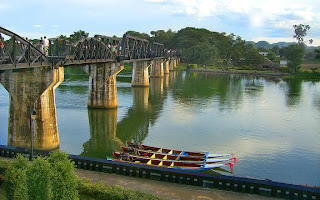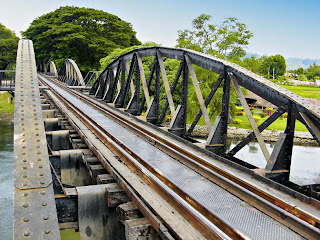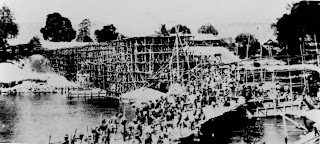During World War 2, the Japanese used Allied prisoners of war to build a railway from Thailand to Burma so they could supply their army without the dangers of sending supplies by sea. Many prisoners died under appalling conditions during its construction, and the line became known as the 'Death Railway'. It was immortalised in David Lean's 1957 film 'The Bridge on the River Kwai' which centres around one of the line's main engineering feats, the bridge across the Kwae Yai river just north of Kanchanburi. Although the film was shot in Sri Lanka, the Bridge on the River Kwai really exists, and still carries regular passenger trains from Bangkok as far as Nam Tok. For anyone interested in 20th century history, a visit to Kanchanaburi and the infamous Death Railway is a must.
 |
| (Thailand) - The Bridge On the River Kwai |
This page gives all the necessary information for train travel from Bangkok to Kanchanburi, the Bridge on the River Kwai & Nam Tok, along with an overview of what there is to see in the area, including the Bridge Over the River Kwai, the Wampo (Wang Po) Viaduct and the museum at Hellfire Pass (Konyu Cutting). You can see the Bridge on the River Kwai as a day trip from Bangkok using the morning train out and afternoon train back, but it's better to make it a 2 or 3 day trip as there's a lot more to see than just the Bridge. For example, you could take the morning passenger train from Bangkok to Kanchanaburi on day 1, stay a night or two in Kanchanaburi, then take the afternoon train back on day 2 or 3, so you can visit Hellfire Pass (less well known than the Bridge, but not be missed) and travel the Death Railway through fantastic scenery over the dramatic Wampo Viaduct as far as its current terminus at Nam Tok.
 |
| (Thailand) - The Bridge On the River Kwai |
 |
| (Thailand) - The Bridge On the River Kwai |
 |
| (Thailand) - The Bridge On the River Kwai |
 |
| (Thailand) - The Bridge On the River Kwai |
 |
| (Thailand) - The Bridge On the River Kwai |
(Seat 61)







No comments:
Post a Comment